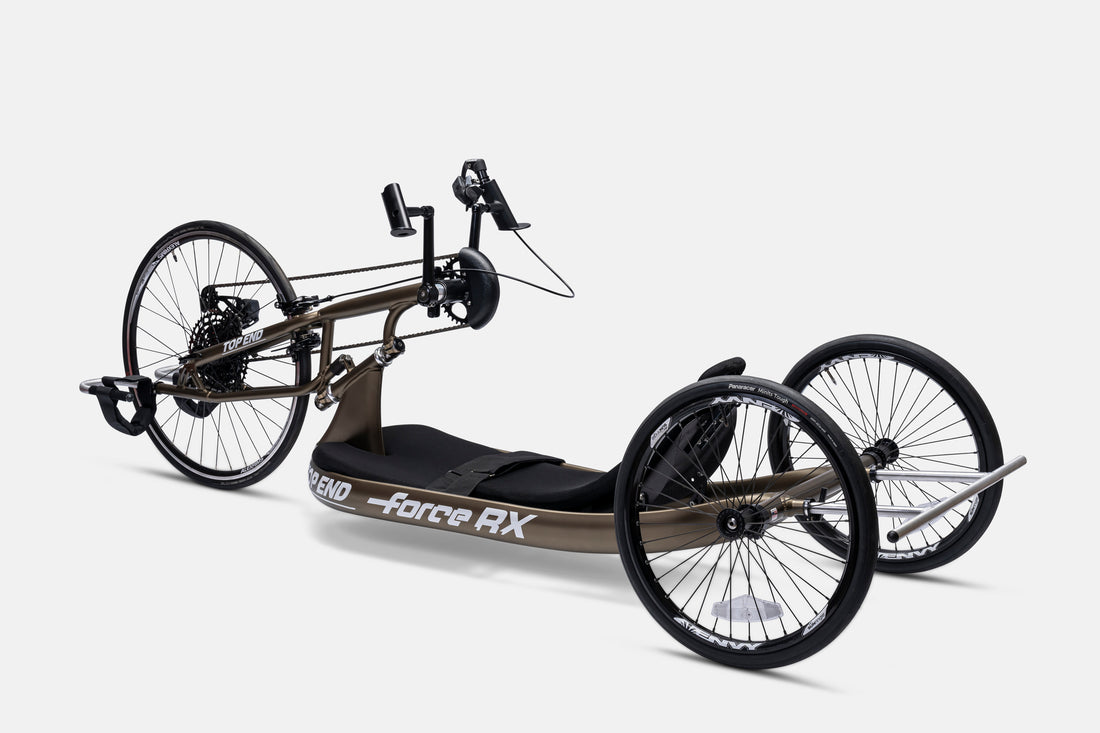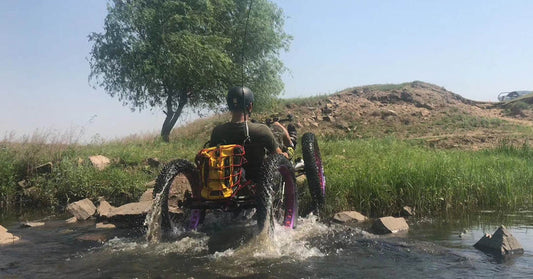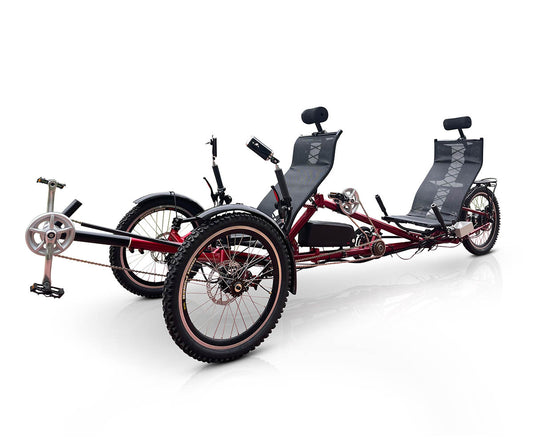
Exploring Accessible Cycling: Handcycles and Electric Bikes for Enhanced Mobility
Share
For individuals navigating life with limited or absent lower body mobility, finding options that offer fun, independence, and freedom is crucial. Both handcycles and electric recumbent bikes stand out as exceptional options in this landscape, each serving as a gateway to new levels of accessibility and engagement with the world. These adaptive bikes do more than facilitate movement; they unlock autonomy, empowerment, and the thrill of adventure, each tailored to meet diverse needs and preferences. Whether through the physical engagement of a handcycle or the assisted ease of an electric recumbent, riders can find the perfect match for their lifestyle and ambitions.
Adding a Little Spark: Electric Solutions for Accessible Cycling
At the heart of recumbent bike innovation is a commitment to inclusivity, particularly for those who find traditional pedaling difficult or impossible. These bikes excel with options that cater to a wide spectrum of needs: from models offering purely electric propulsion without any need for pedals, designed for individuals requiring a completely pedal-free experience, to dual-mode bikes that combine fully electric and electric assist functionalities. This variety ensures a flexible alternative to traditional leg-pedaled bikes, allowing riders to tailor their cycling experience to their specific conditions and preferences.
The purely electric models are activated with just the touch of a button or a twist of a throttle, moving the bike forward effortlessly and granting users the freedom to traverse distances without the need for leg movement. Meanwhile, the dual-mode functionality in other models detects the rider's pedaling effort, offering a proportional electric boost when desired. This electric assist is invaluable for those looking to ease the physical demands of cycling, especially over challenging terrains and steep ascents, thereby broadening accessibility and enjoyment of cycling to a diverse audience.
Electric recumbent bikes, in their various configurations, significantly expand the community of cyclists by providing options that accommodate those with disabilities and various levels of leg and lower body functionality. Whether through a bike designed for fully electric operation that eliminates the need for pedaling or one that lightens the load with electric assist, these innovative vehicles emerge as compelling substitutes and/or modifications for handcycles. They offer a less physically demanding yet deeply rewarding cycling experience, inviting everyone to embrace the joy and liberation of cycling, free from physical constraints.
There are four main cycle options that don't rely entirely on lower-body propulsion:
- Handcycles: Operated with hand cranks instead of foot pedals, handcycles allow individuals with limited or no leg mobility to enjoy cycling using their upper body strength.
- Fully Electric Cycles: These bikes provide complete propulsion through an electric motor, eliminating the need for physical pedaling and offering an effortless ride.
- Electric Assisted Leg Pedals: Ideal for those with partial leg mobility, these systems add a boost to natural pedaling efforts, easing the strain of cycling over various terrains.
- Electric Assisted Hand Pedals: Merging handcycle functionality with electric assistance, these enable easier and faster rides, perfect both for those looking to multiply the work they're already putting in and for those who may want to reduce upper body exertion entirely.
Key Accessibility Features of Hand Cycles
Handcycles offer specialized features tailored to meet the needs of individuals with limited leg functionality. Here's a detailed look at some of the key features that enhance accessibility and provide a comfortable riding experience:
- Crank Configuration: The vast majority of handcycles today feature hand cranks that are aligned in parallel rather than in opposite alignment. This parallel setup facilitates easier steering and reduces the risk of the rider's hands hitting their thighs during turns, providing a more comfortable ride.
- Seating Options: Handcycles come in three main seating configurations:
- Recumbent: Most common and provides a low center of gravity for better stability.
- Upright: Offers a more traditional seating position, which some riders may prefer for visibility and ease of transfer.
- Kneeling: Mostly used in racing due to its aerodynamic advantages, but also available in recreational models for those who find this position comfortable.
- Steering and Wheel Configurations: The functionality and efficiency of handcycles are greatly influenced by their steering mechanisms and wheel configurations.
- Steering Mechanisms:
- Many handcycles use fork steering, where the front wheel is attached to the pedal assembly via a roll axis, allowing steering through movements of the front wheel directly.
- Alternatively, some models feature under-seat steering with outer handlebars, similar to under-seat steering systems found on recumbent leg cycles.
- Wheel Configurations:
- Delta: This is the predominant configuration, featuring one wheel in front and two behind. It supports fork steering well because it allows for a compact design with shorter chains and shifters at the front, minimizing the destabilizing effect seen in other delta trikes.
- Tadpole: Less common in handcycles but used for specific applications, especially in off-road models. These often have higher ground clearance to handle rougher terrain and may combine fork and under-seat steering for improved control.
- Off-Road Capabilities: For those interested in off-road hand cycling, kneeling or prone positions are often favored. These positions can be paired with a delta configuration, incorporating a secondary set of handlebars placed traditionally like those on a two-wheeled bike. This setup provides enhanced control, particularly on downhill stretches, by allowing varied steering inputs. For an example of a kneeling tadpole trike, watch this video to see one man’s custom solution for an off-road handcycle.
These features collectively make handcycles a versatile and adaptive choice for many individuals, providing options that cater to a range of preferences and physical needs. Whether seeking a vehicle for everyday use or competitive racing, handcycles can be tailored to provide an empowering and enjoyable cycling experience.
Key Accessibility Features of Electric Recumbent Bikes
Electric recumbent bikes are equipped with several features designed to enhance the cycling experience for individuals with varying degrees of leg mobility. These bikes combine ease of use with advanced technology to ensure accessibility and comfort for all riders.
- Hand Controls: Electric recumbent bikes often include hand controls for braking and gear shifting. This adaptation allows individuals who cannot use traditional leg-operated controls to manage their rides safely and effectively, enhancing user independence.
- Adjustable Seating: To maximize comfort, especially during long rides, these bikes offer adjustable seating. This feature allows the seat to be customized to fit the rider's body shape and size, ensuring optimal support and minimizing the risk of discomfort.
- Customizable Pedal Systems: Electric recumbent bikes cater to various mobility needs with customizable pedal systems. These systems may include adjustable pedal positions and the integration of foot straps or cages, which help secure the rider's feet and maintain stability, particularly beneficial for those with partial leg functionality.
- Fully Electric Operation: Many models provide a fully electric mode, eliminating the need for pedaling. This feature is crucial for riders with limited or no leg mobility, as it allows the bike to be propelled solely by its motor. Opting for an electric recumbent bike with this capability can significantly enhance the cycling experience by removing physical barriers and extending the range of exploration.
The electric assist technology employed in these bikes is particularly innovative, adjusting the level of power assistance based on the force exerted by the rider. This capability ensures that each individual's physical condition is accommodated, making electric recumbent bikes a comprehensive mobility solution for enjoying the benefits of cycling without limitations.
Benefits of Choosing a Handcycle
Handcycles offer unique advantages that make them a valuable option for individuals seeking alternative mobility solutions:
- Reduced Lower Body Strain: Handcycles are ideal for people with limited lower body mobility or injuries, particularly in the knees or ankles, as they allow cycling using upper body strength. This can alleviate pain and prevent strain on lower body joints.
- Upper Body Workout: Operating a handcycle provides a robust workout for the arms and chest, promoting upper body strength and endurance, which can be particularly beneficial for those looking to balance their physical fitness and focus on upper body conditioning.
- Engaging Riding Experience: Handcycling introduces a different kind of kinetic engagement, as riders use their arms to propel themselves. This can feel more interactive and fun, offering a novel and involved experience compared to traditional leg-based cycling.
- Better Accessibility in Crowded Areas: Handcycles typically have a more compact design than some recumbent trikes and quads, making them easier to maneuver in urban environments. This compactness can be advantageous in crowded or narrow spaces, enhancing mobility in city settings.
- Enhanced Hand-Eye Coordination: The operation of a handcycle requires synchronizing visual cues with upper body actions, which can improve hand-eye coordination. This skill is not only valuable for the sport itself but also transfers well to daily activities, supporting overall dexterity and motor skills.
- Cost Effectiveness: Generally, handcycles tend to be more affordable than fully electric or electric assist trikes, making them an economical option for those looking to enjoy cycling without a significant financial investment.
- Legal Flexibility: Unlike fully electric recumbent bikes, which in many states fall under stricter regulations due to the three-class electric bike system, handcycles often enjoy fewer restrictions. This can extend the range of places and trails where handcycles can be legally ridden, offering greater freedom in route selection. For more details about the classifications and restrictions of electric adaptive bikes, check out our comprehensive article on electric cycles.
These benefits collectively highlight the practicality and appeal of handcycles as a dynamic alternative for adaptive cycling, enriching the cycling experience with physical health benefits, increased accessibility, and distinctive riding enjoyment.
Benefits of Choosing Electric Recumbent Bikes
Electric recumbent bikes offer a range of benefits that enhance the cycling experience, especially when compared to more traditional cycling options like handcycles:
- Ease of Use: Electric recumbent bikes simplify the cycling process by using electric propulsion, which requires minimal physical effort from the rider. This feature makes cycling more accessible and enjoyable, particularly for those who may find manual pedaling challenging.
- Extended Range: These bikes are equipped with batteries that enable long distances to be covered on a single charge. Depending on the battery type and terrain, riders can expect a minimum of 20 miles on full electric mode, allowing for greater exploration and adventure without fatigue.
- Hill Climbing Made Easy: The physical effort required to ascend hills on a handcycle can be daunting due to the disadvantage of the power-to-weight ratio. Electric recumbent bikes with assistive technologies make climbing much easier, expanding accessible terrain and reducing the barrier that steep inclines might pose.
- Reduced Physical Exertion: By minimizing the strain of cycling, electric recumbent bikes are ideal for those with limited leg functionality or anyone wishing to enjoy the outdoors with less effort. This reduction in physical demand enhances mobility and increases access to outdoor activities, fostering greater independence.
- Versatile Configurations: Unlike handcycles, which typically use a delta configuration (two wheels at the back), electric recumbent bikes are available in tadpole (two wheels in front) and quad configurations. Tadpole models, in particular, offer improved stability and handling, which can be beneficial at higher speeds.
Electric recumbent bikes provide a modern alternative to traditional cycling, making them a superb choice for those seeking a less physically demanding yet enriching outdoor experience. For more detailed information on the various configurations and their advantages, consider exploring our comprehensive guide on recumbent bike features.
Embracing New Paths: Discover the Freedom of Adaptive Cycling
As we explore the options for those with restricted or absent lower limb mobility, handcycles and electric recumbent bikes stand out not just as mobility aids but as gateways to independence and adventure. These adaptive solutions allow individuals to connect actively with the outdoors and enjoy the benefits of cycling, customized to their needs.
For those beginning to investigate adaptive cycling or aiming to deepen their understanding of available options, our comprehensive resources can guide your decision. Our article on electric and e-assist adaptive cycles offers insights, tips, and a more in depth look at the topic, while our overview on all things adaptive bikes provides a broad look at various models and their features, ensuring you have all the necessary information.
With the right adaptive bike, every ride is an opportunity to explore new landscapes and experience the joy of cycling, tailored to your unique needs. Start your journey today and embrace the freedom that comes with every turn of the wheels.


